Experimental Study on Ultrasonic Assisted Turning of GH4068 Superalloy
Abstract
1. Introduction
2. Materials and Methods
2.1. Tools and Materials
2.2. Machining System of UAT
2.3. Experimental Methods
3. Result and Discussion
3.1. Cutting Force
3.2. Surface Roughness
3.3. Surface Morphology
3.4. Chip Morphology
4. Conclusions
- Choosing the appropriate process parameters of UAT can reduce the cutting force of GH4068 superalloy. When the cutting speed is 14–53 m/min, the feed speed is 0.08–0.24 mm/rev, and the cutting depth is 0.10–0.25 mm, the cutting force decreases significantly. Compared with CT, the Fx and Fy are reduced by a maximum of 44% and 63%, respectively. The reduction of cutting force decreases as process parameters are increased, but UAT still has a significant impact on reducing cutting force.
- When the cutting speed is lower than the critical speed, UAT has a significant effect on reducing the surface roughness, when the cutting speed is 14–53 m/min, the feed speed is 0.08–0.24 mm/rev, the cutting depth is 0.10–0.25 mm, the effect of UAT is obvious, reducing surface roughness by a maximum of 31%.
- When using UAT and CT GH4068 superalloy, the surface morphology is obviously different. CT’s surface profile exhibits obvious periodicity. Scratches of different sizes are visible on the machined surface. UAT obtains a smoother surface, and the ultrasonic vibration produces complex ripples, and the tool marks are uniform in size and distribution.
- The UAT chip is short, the chip-breaking effect is obvious, and the edge of the chip forms relatively smooth rectangular sawteeth. The chip surface is smooth and delicate. For CT, the chip bending radius is large, and the edge of the chip formed many sharp sawteeth.
Author Contributions
Funding
Institutional Review Board Statement
Informed Consent Statement
Data Availability Statement
Conflicts of Interest
References
- Guo, Y.B.; Li, W.; Jawahir, I.S. Surface integrity characterization and prediction in machining of hardened and difficult-to-machine alloys: A state-of-art research review and analysis. Mach. Sci. Technol. 2009, 13, 437–470. [Google Scholar] [CrossRef]
- M’Saoubi, R.; Outeiro, J.C.; Chandrasekaran, H.; Dillon, O.W., Jr.; Jawahir, I.S. A review of surface integrity in machining and its impact on functional performance and life of machined products. Int. J. Sustain. Manuf. 2008, 1, 203–236. [Google Scholar] [CrossRef]
- Thakur, D.G.; Ramamoorthy, B.; Vijayaraghavan, L. Study on the machinability characteristics of superalloy Inconel 718 during high speed turning. Mater. Des. 2009, 30, 1718–1725. [Google Scholar] [CrossRef]
- Pollock, T.M.; Tin, S. Nickel-Based Superalloys for Advanced Turbine Engines: Chemistry, Microstructure and Properties. J. Propuls. Power 2006, 22, 361–374. [Google Scholar] [CrossRef]
- Ulutan, D.; Ozel, T. Machining induced surface integrity in titanium and nickel alloys: A review. Int. J. Mach. Tools Manuf. 2011, 51, 250–280. [Google Scholar] [CrossRef]
- Zhang, R.; Liu, P.; Cui, C.Y.; Qu, J.L.; Zhang, B.J.; Du, J.H.; Zhou, Y.Z.; Sun, X.F. Present Research Situation and Prospect of Hot Working of Cast & Wrought Superalloys for Aero-Engine Turbine Disk in China. Acta Metall. Sin. 2021, 57, 1215–1228. (In Chinese) [Google Scholar]
- Ezugwu, E.O.; Bonney, J.; Yamane, Y. An overview of the machinability of aeroengine alloys. J. Mater. Process. Technol. 2003, 134, 233–253. [Google Scholar] [CrossRef]
- Airao, J.; Nirala, C.K.; de Lacalle, L.N.L.; Khanna, N. Tool Wear Analysis during Ultrasonic Assisted Turning of Nimonic-90 under Dry and Wet Conditions. Metals 2021, 11, 1253. [Google Scholar] [CrossRef]
- Sharma, V.; Pandey, P.M. Recent advances in ultrasonic assisted turning: A step towards sustainability. Cogent Eng. 2016, 3, 1222776. [Google Scholar] [CrossRef]
- Xu, Y.; Wan, Z.; Zou, P.; Huang, W.; Zhang, G. Experimental Study on Cutting Force in Ultrasonic Vibration-Assisted Turning of 304 Austenitic Stainless Steel. Proc. Inst. Mech. Eng. Part B-J. Eng. Manuf. 2021, 235, 494–513. [Google Scholar] [CrossRef]
- Shamoto, E.; Ma, C.X.; Moriwaki, T. Ultraprecision ductile cutting of glass by applying ultrasonic elliptical vibration cutting. In Proceedings of the European Society for Precision Engineering and Nanotechnology, Bremen, Germany, 31 May–4 June 1999; pp. 408–411. [Google Scholar]
- Liu, C.S.; Zhao, B.; Gao, G.F.; Jiao, F. Research on the characteristics of the cutting force in the vibration cutting of a particle-reinforced metal matrix composites SiCp/Al. J. Mater. Process. Technol. 2002, 129, 196–199. [Google Scholar] [CrossRef]
- Chen, X.; Tang, J.; Shao, W.; Hu, B.; Ye, J. An Analytical and Experimental Study on Cutting Characteristics and Transient Cutting Force Modeling in Feed Directional Ultrasonic Vibration-Assisted Cutting of High Strength Alloys. Materials 2022, 15, 7388. [Google Scholar] [CrossRef]
- Maurotto, A.; Muhammad, R.; Roy, A.; Silberschmidt, V.V. Enhanced ultrasonically assisted turning of a beta-titanium alloy. Ultrasonics 2013, 53, 1242–1250. [Google Scholar] [CrossRef]
- Lotfi, M.; Amini, S.; Aghaei, M. 3D analysis of surface topography in vibratory turning. Int. J. Adv. Manuf. Technol. 2018, 95, 197–204. [Google Scholar] [CrossRef]
- Yan, L.; Zhang, Q.; Yu, J. Effects of continuous minimum quantity lubrication with ultrasonic vibration in turning of titanium alloy. Int. J. Adv. Manuf. Technol. 2018, 98, 827–837. [Google Scholar] [CrossRef]
- Xu, Y.; Wan, Z.; Zou, P.; Zhang, Q. Experimental study on chip shape in ultrasonic vibration–assisted turning of 304 austenitic stainless steel. Adv. Mech. Eng. 2019, 11, 1687814019870896. [Google Scholar] [CrossRef]
- Bai, W.; Bisht, A.; Roy, A.; Suwas, S.; Sun, R.; Silberschmidt, V.V. Improvements of machinability of aerospace-grade Inconel alloys with ultrasonically assisted hybrid machining. Int. J. Adv. Manuf. Technol. 2018, 101, 1143–1156. [Google Scholar] [CrossRef]
- Airao, J.; Khanna, N.; Roy, A.; Hegab, H. Comprehensive experimental analysis and sustainability assessment of machining Nimonic 90 using ultrasonic-assisted turning facility. Int. J. Adv. Manuf. Technol. 2020, 109, 1447–1462. [Google Scholar] [CrossRef]
- Nath, C.; Rahman, M. Effect of machining parameters in ultrasonic vibration cutting. Int. J. Mach. Tools Manuf. 2008, 48, 965–974. [Google Scholar] [CrossRef]
- Babitsky, V.I.; Kalashnikov, A.N.; Meadows, A.; Wijesundara, A. Ultrasonically assisted turning of aviation materials. J. Mater. Process. Technol. 2003, 132, 157–167. [Google Scholar] [CrossRef]
- Airao, J.; Nirala, C.K. Machinability of Ti-6Al-4V and Nimonic-90 in ultrasonic-assisted turning under sustainable cutting fluid. Mater. Today: Proc. 2022, 62, 7396–7400. [Google Scholar] [CrossRef]
- Airao, J.; Khanna, N.; Nirala, C.K. Tool Wear Reduction in Machining Inconel 718 by Using Novel Sustainable Cryo-Lubrication Techniques. Tribol. Int. 2022, 175, 107813. [Google Scholar] [CrossRef]
- Wang, M.; Huang, X.; Xue, P.; Wu, S.; Cui, C.; Zhang, Q. High strength and ductility achieved in friction stir processed Ni-Co based superalloy with fine grains and nanotwins. J. Mater. Sci. Technol. 2021, 106, 162–172. [Google Scholar] [CrossRef]
- Liu, P.; Zhang, R.; Yuan, Y.; Cui, C.; Zhou, Y.; Sun, X. Hot deformation behavior and workability of a Ni-Co based superalloy. J. Alloy. Compd. 2020, 831, 154618. [Google Scholar] [CrossRef]
- Yang, Z.; Zhu, L.; Zhang, G.; Ni, C.; Lin, B. Review of ultrasonic vibration-assisted machining in advanced materials. Int. J. Mach. Tools Manuf. 2020, 156, 103594. [Google Scholar] [CrossRef]
- Xu, Y.; Gao, F.; Zou, P.; Zhang, Q.; Fan, F. Theoretical and experimental investigations of surface roughness, surface topography, and chip shape in ultrasonic vibration-assisted turning of Inconel 718. J. Mech. Sci. Technol. 2020, 34, 3791–3806. [Google Scholar] [CrossRef]
- Ahmed, N.; Mitrofanov, A.V.; Babitsky, V.I.; Silberschmidt, V.V. Analysis of material response to ultrasonic vibration loading in turning Inconel 718. Mater. Sci. Eng. A 2006, 424, 318–325. [Google Scholar] [CrossRef]
- Ahmed, N.; Mitrofanov, A.V.; Babitsky, V.I.; Silberschmidt, V.V. Analysis of forces in ultrasonically assisted turning. J. Sound Vib. 2007, 308, 845–854. [Google Scholar] [CrossRef]
- Babitsky, V.I.; Mitrofanov, A.V.; Silberschmidt, V.V. Ultrasonically assisted turning of aviation materials: Simulations and experimental study. Ultrasonics 2004, 42, 81–86. [Google Scholar] [CrossRef]
- Pang, Y.; Ma, Y.; Xu, C.; Feng, P.F. Finite element simulation of ultrasonic vibration turning titanium alloy. Diam. Abras. Eng. 2019, 39, 83–88. [Google Scholar] [CrossRef]
- Silberschmidt, V.V.; Mahdy, S.M.A.; Gouda, M.A.; Naseer, A.; Maurotto, A.; Roy, A. Surface-roughness Improvement in Ultrasonically Assisted Turning. Procedia CIRP 2014, 13, 49–54. [Google Scholar] [CrossRef]
- Khanna, N.; Airao, J.; Gupta, M.K.; Song, Q.; Liu, Z.; Mia, M.; Maruda, R.; Krolczyk, G. Optimization of Power Consumption Associated with Surface Roughness in Ultrasonic Assisted Turning of Nimonic-90 Using Hybrid Particle Swarm-Simplex Method. Materials 2019, 12, 3418. [Google Scholar] [CrossRef]
- Hua, Y.; Liu, Z. Experimental Investigation of Principal Residual Stress and Fatigue Performance for Turned Nickel-Based Superalloy Inconel 718. Materials 2018, 11, 879. [Google Scholar] [CrossRef]
- Sajjady, S.; Abadi, H.N.H.; Amini, S.; Nosouhi, R. Analytical and experimental study of topography of surface texture in ultrasonic vibration assisted turning. Mater. Des. 2016, 93, 311–323. [Google Scholar] [CrossRef]
- Zhang, X.; Zheng, G.; Cheng, X.; Xu, R.; Zhao, G.; Tian, Y. Fractal Characteristics of Chip Morphology and Tool Wear in High-Speed Turning of Iron-Based Super Alloy. Materials 2020, 13, 1020. [Google Scholar] [CrossRef]



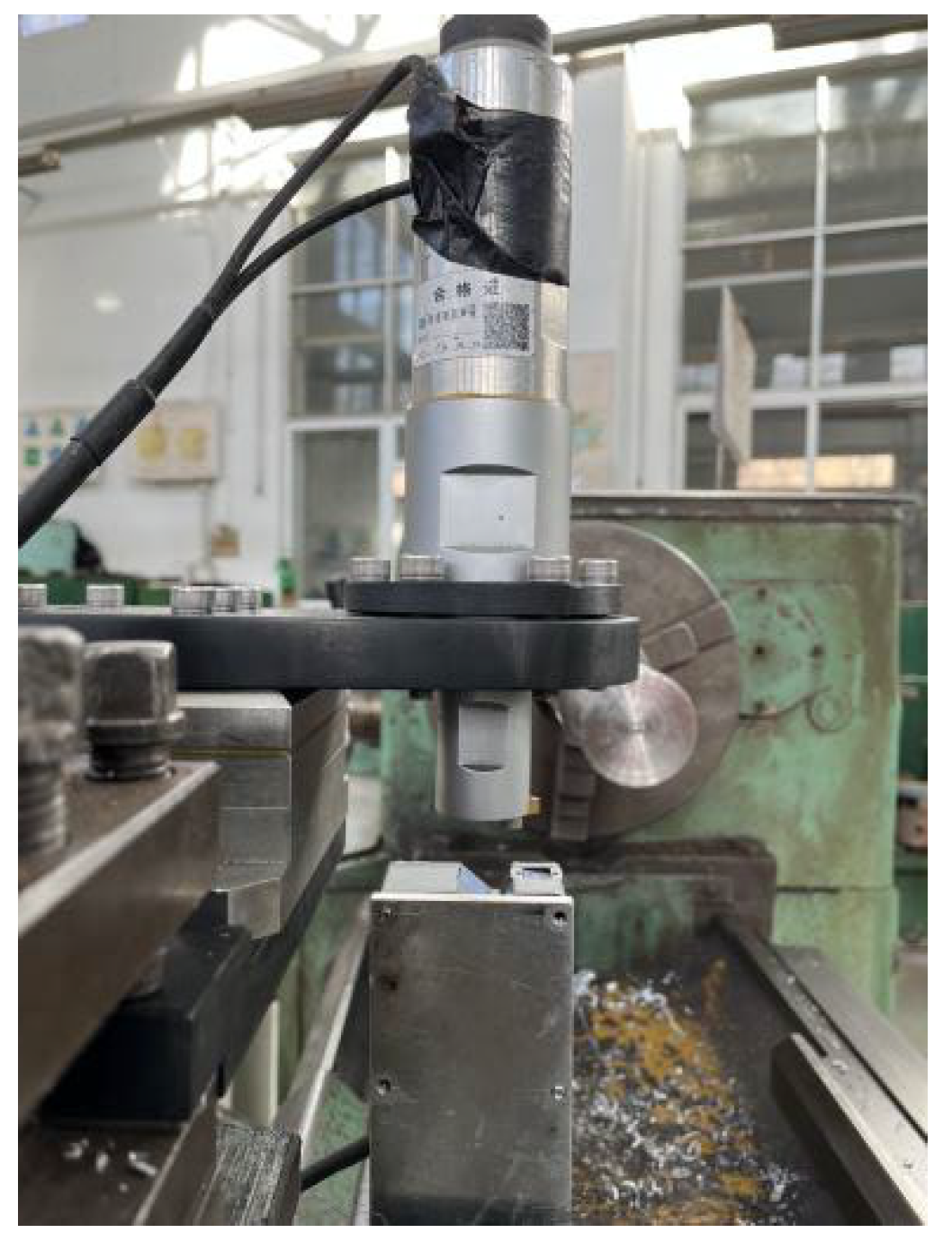

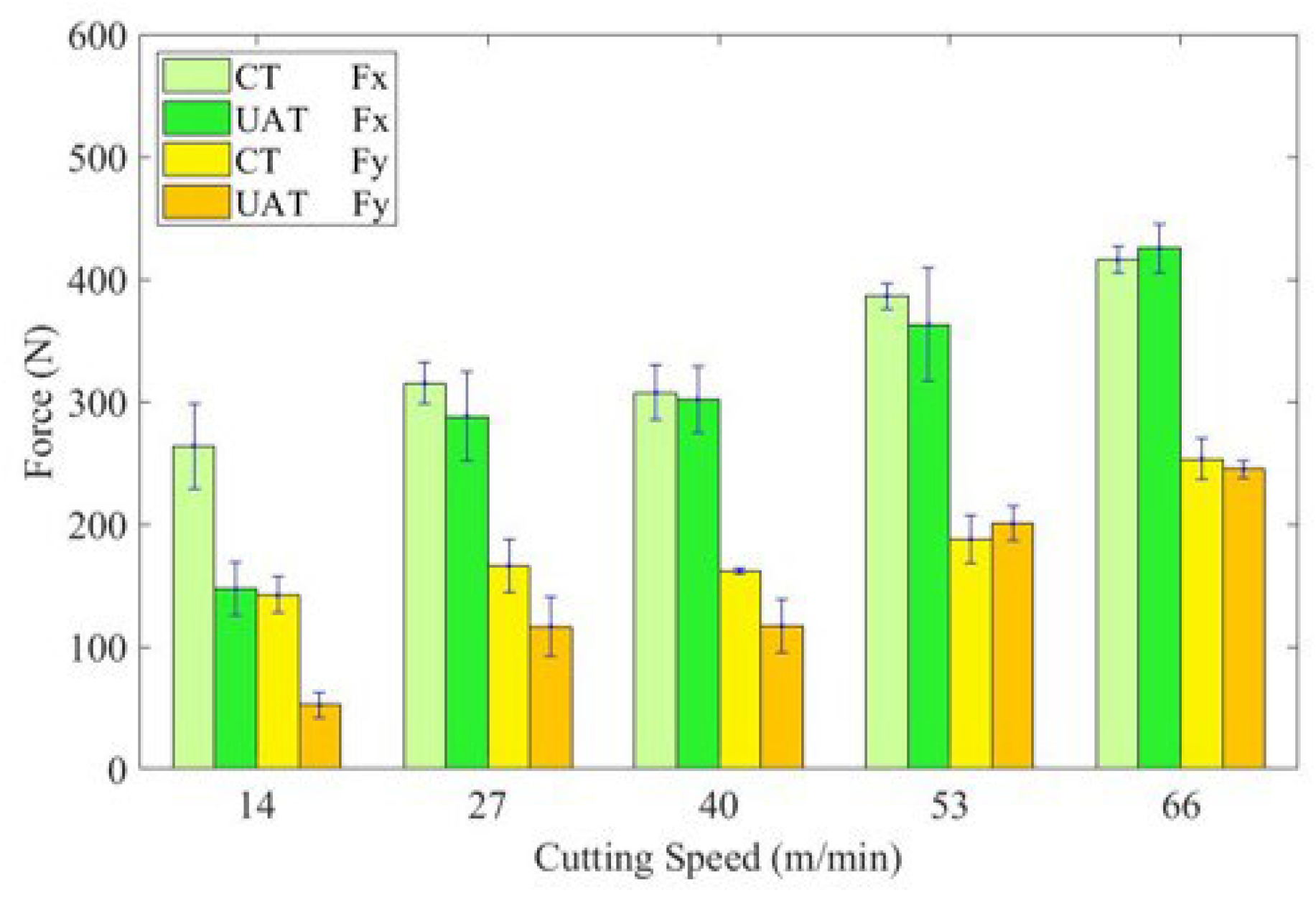
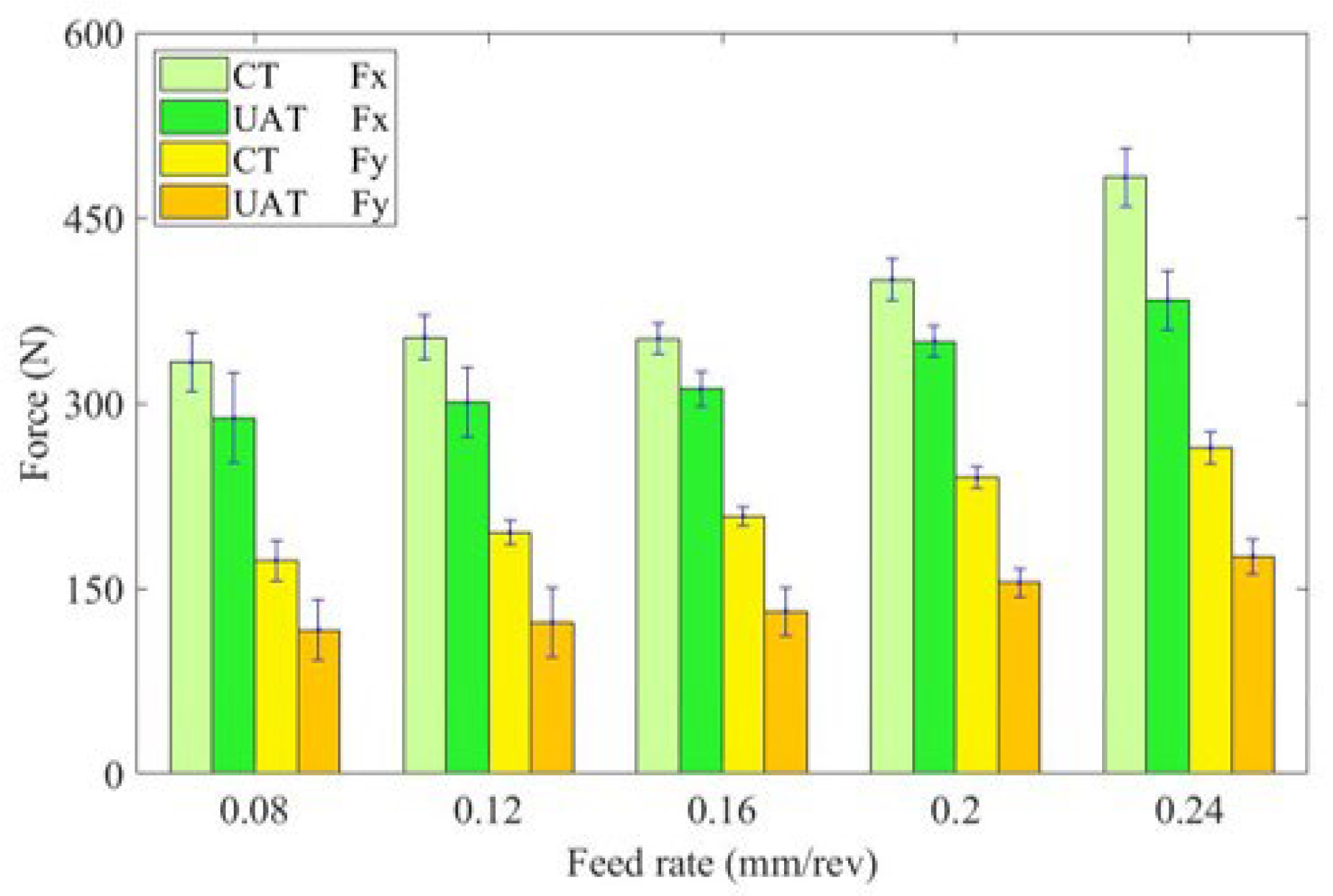
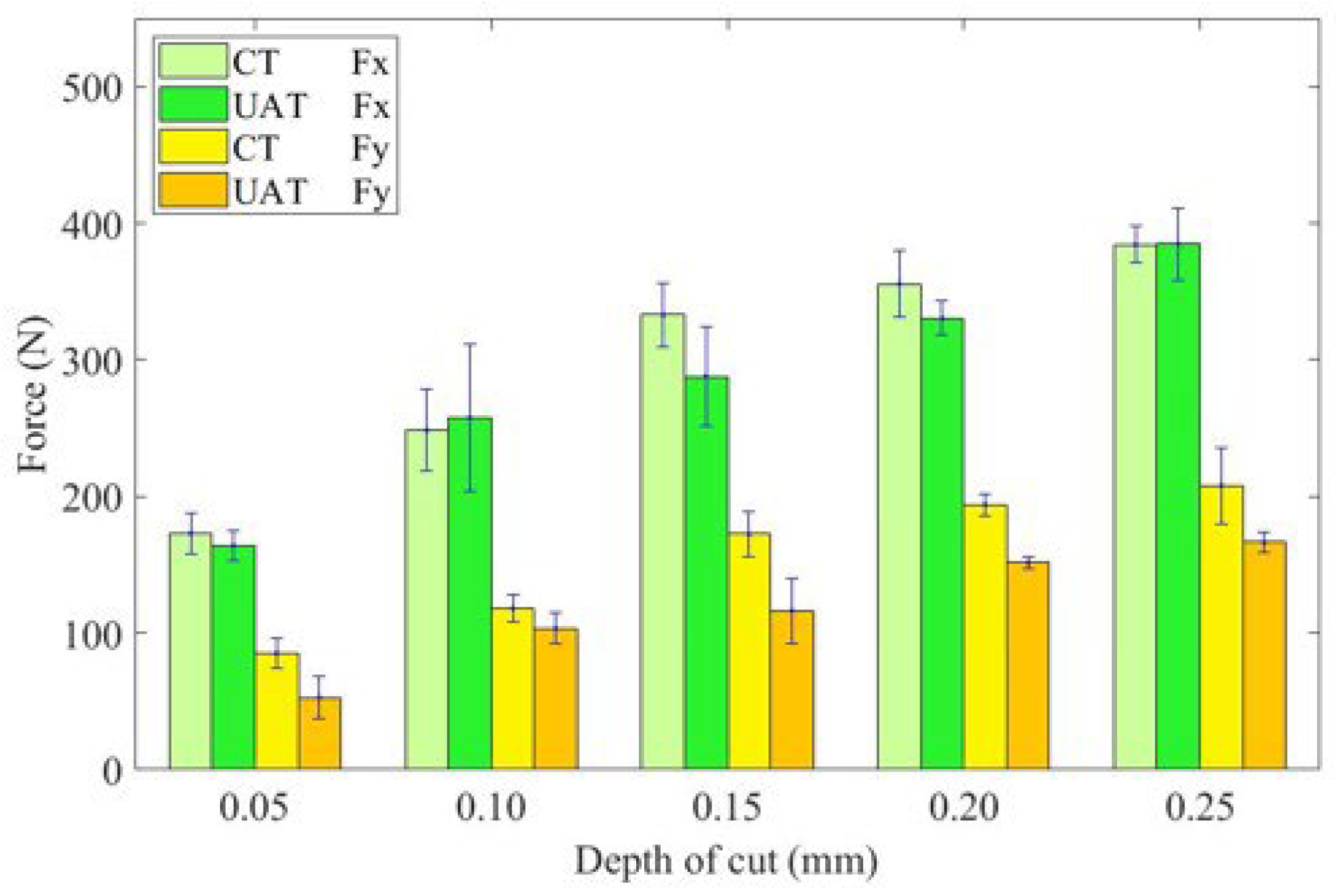
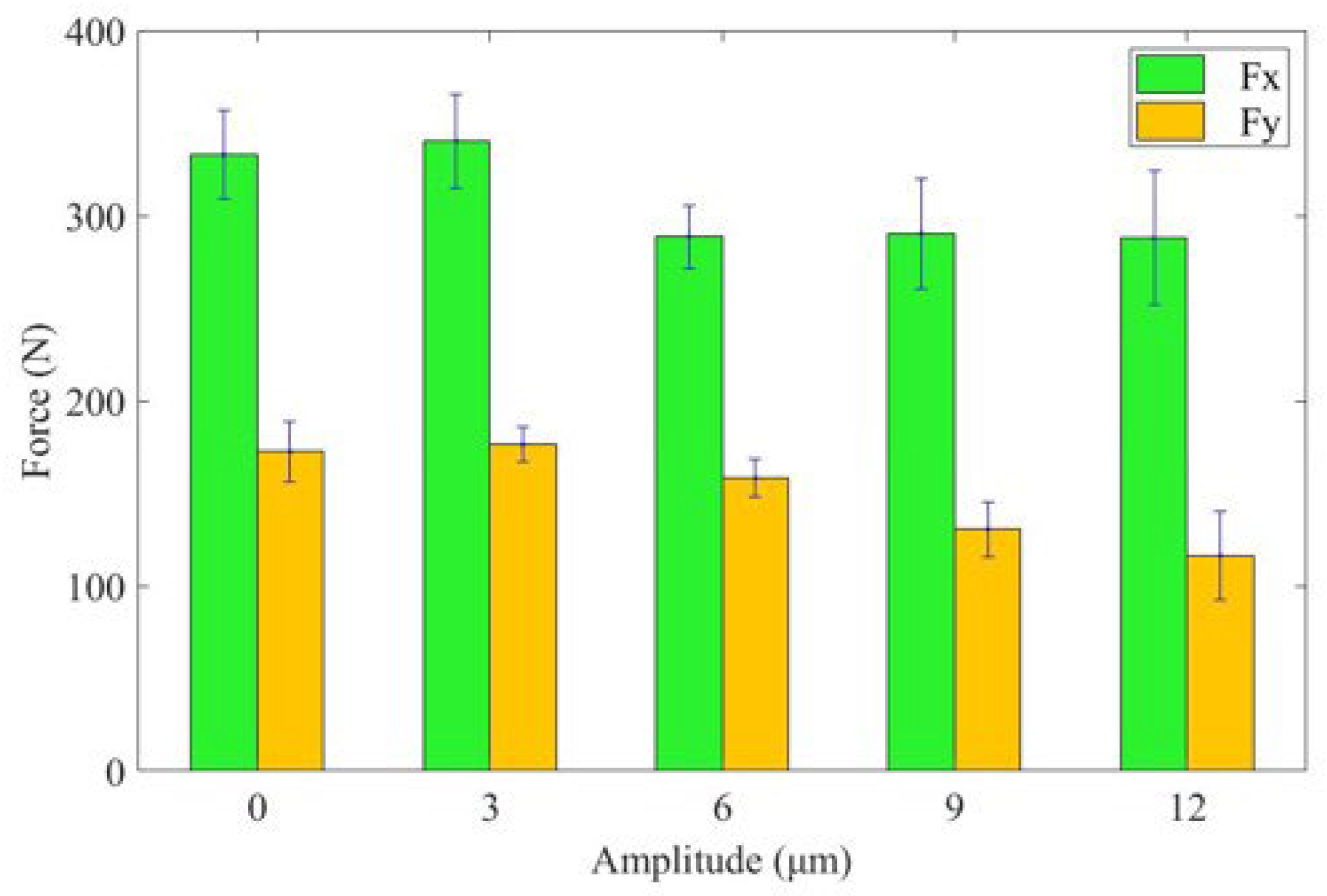
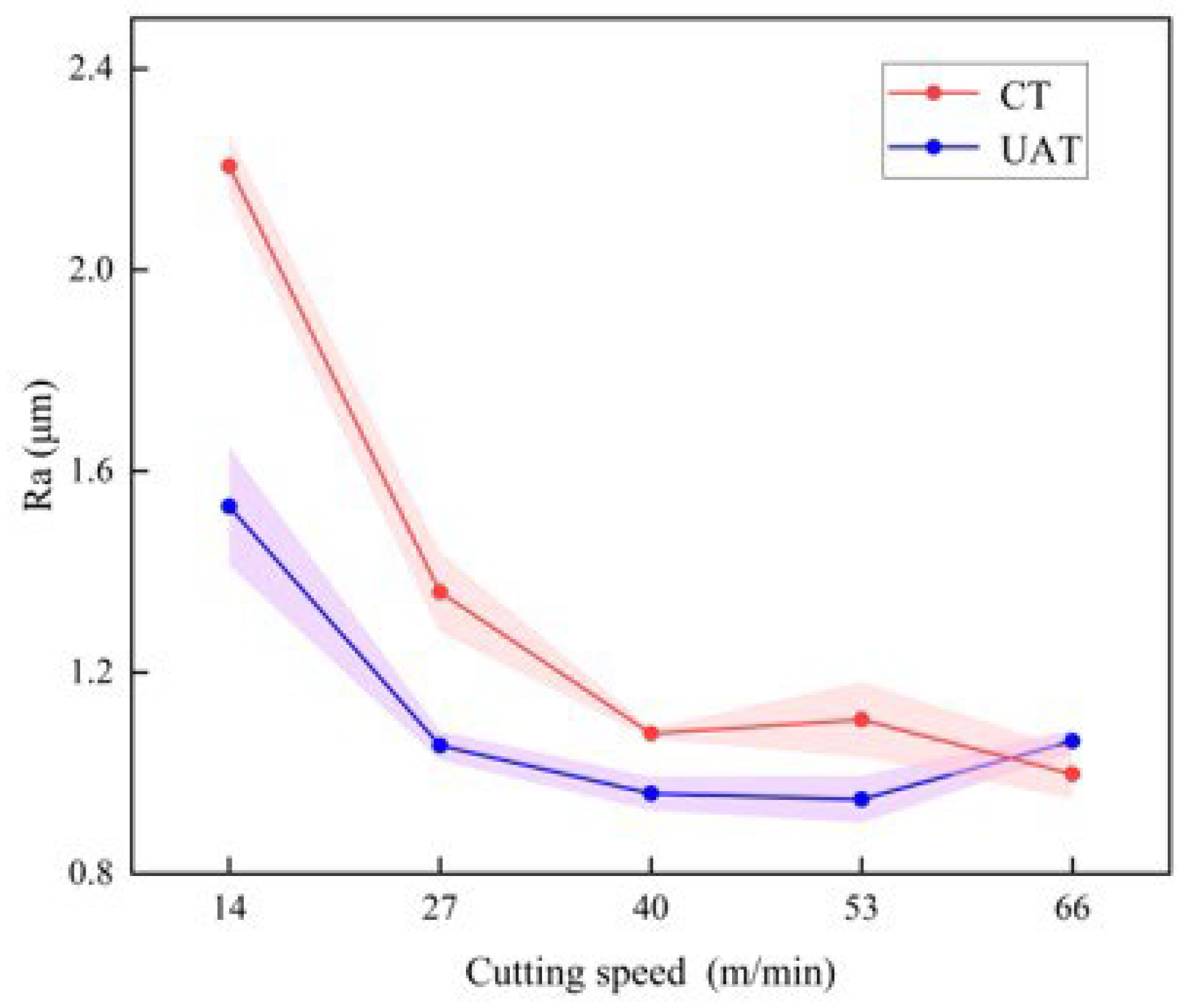
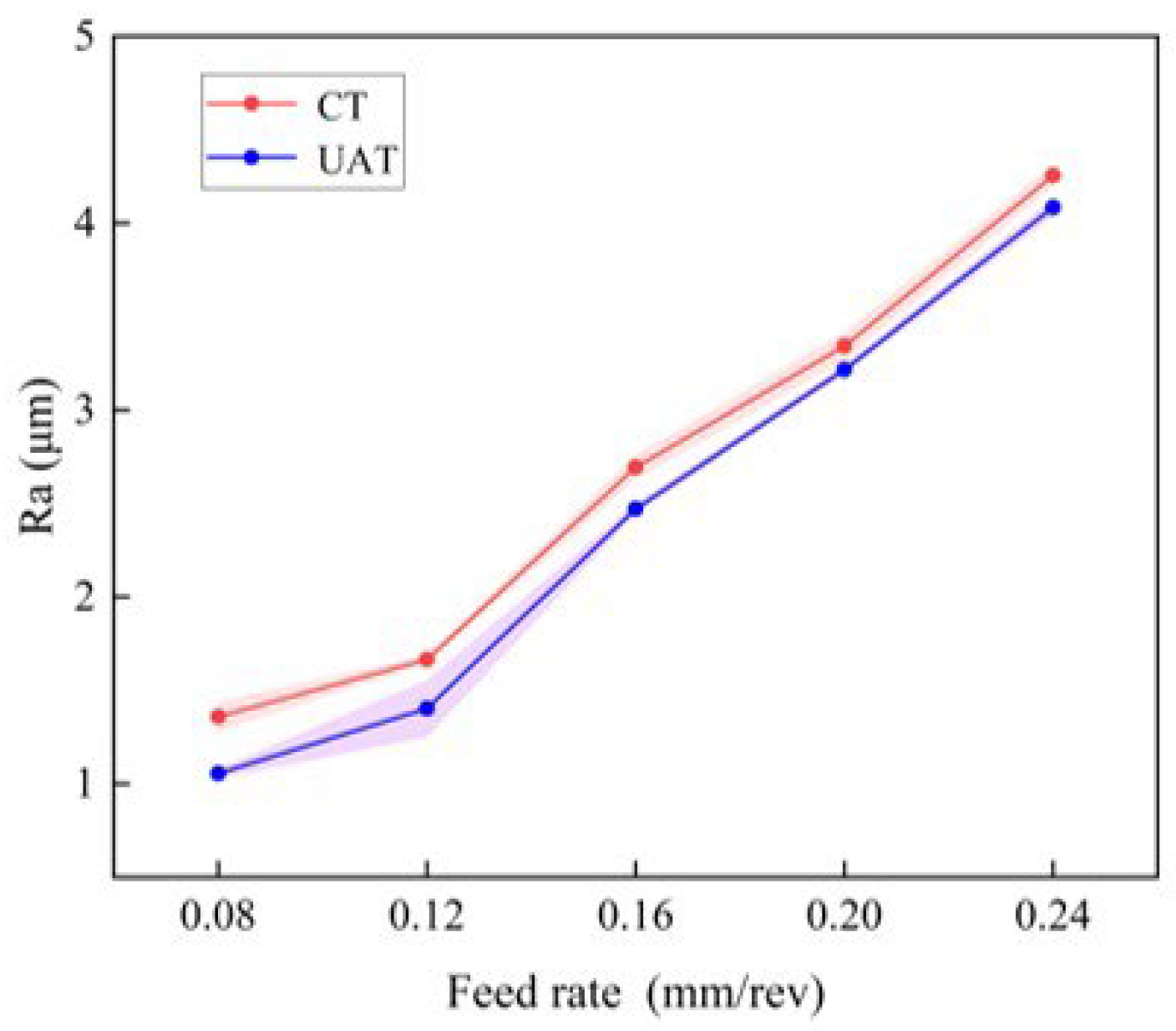
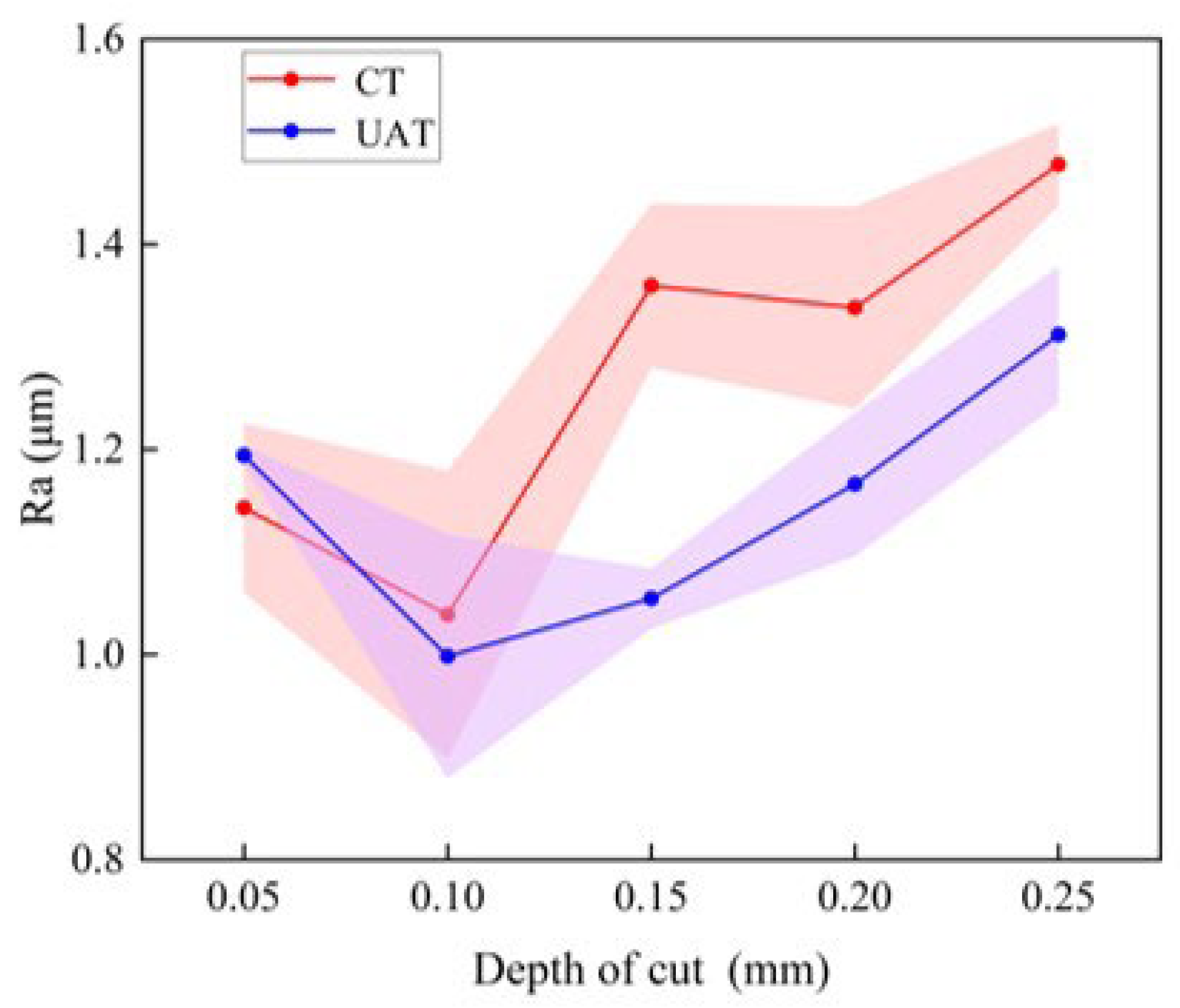

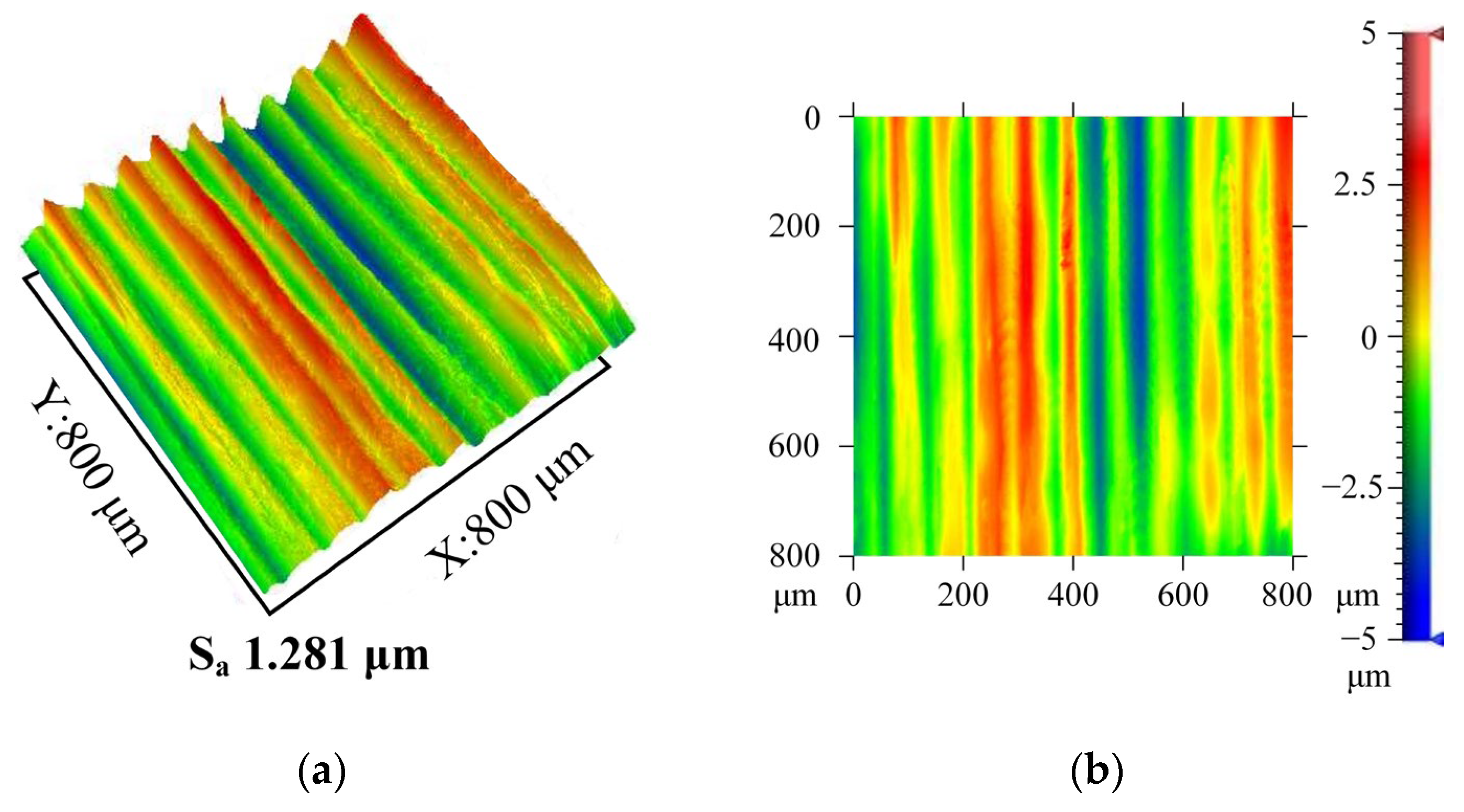

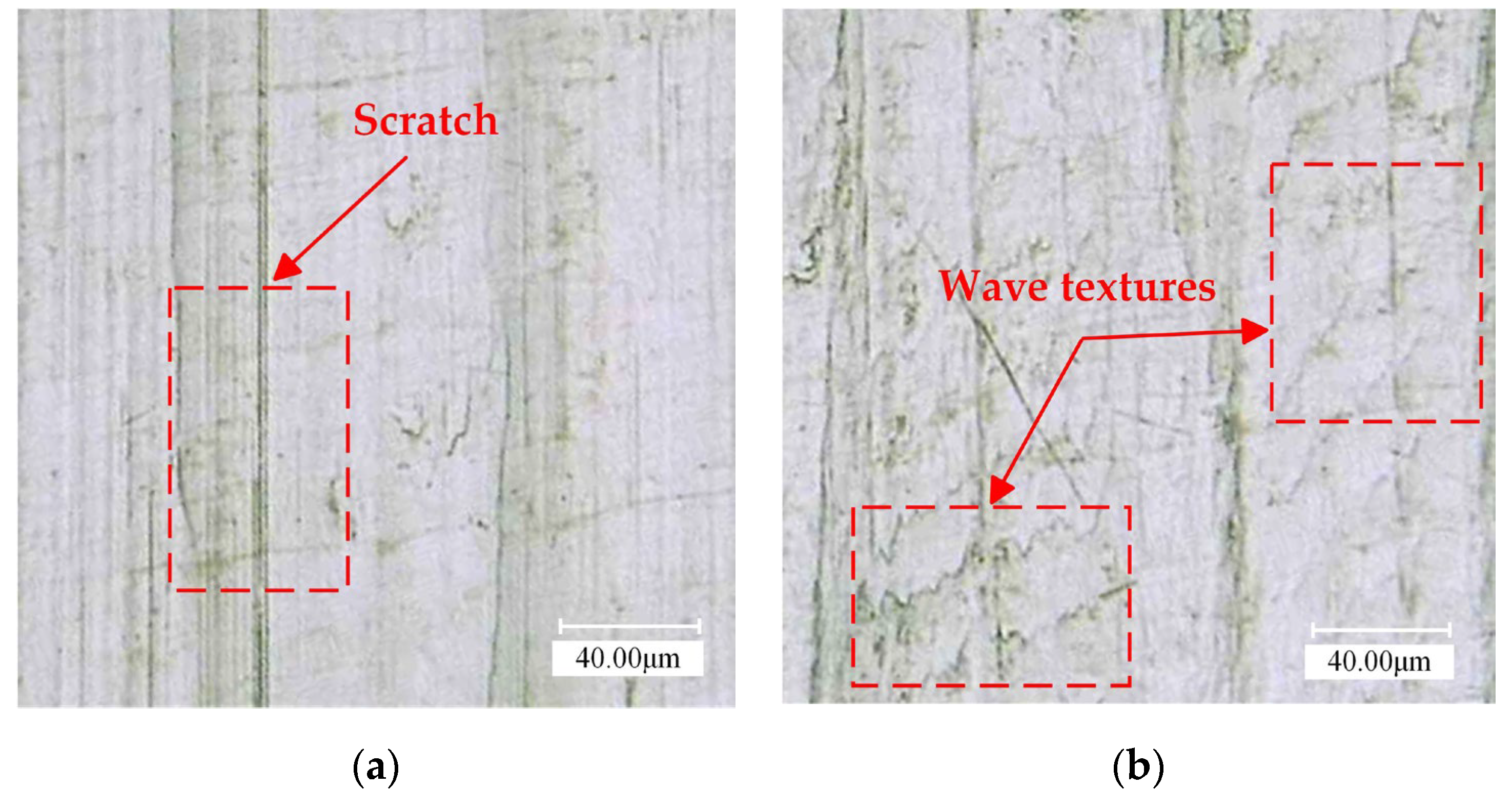
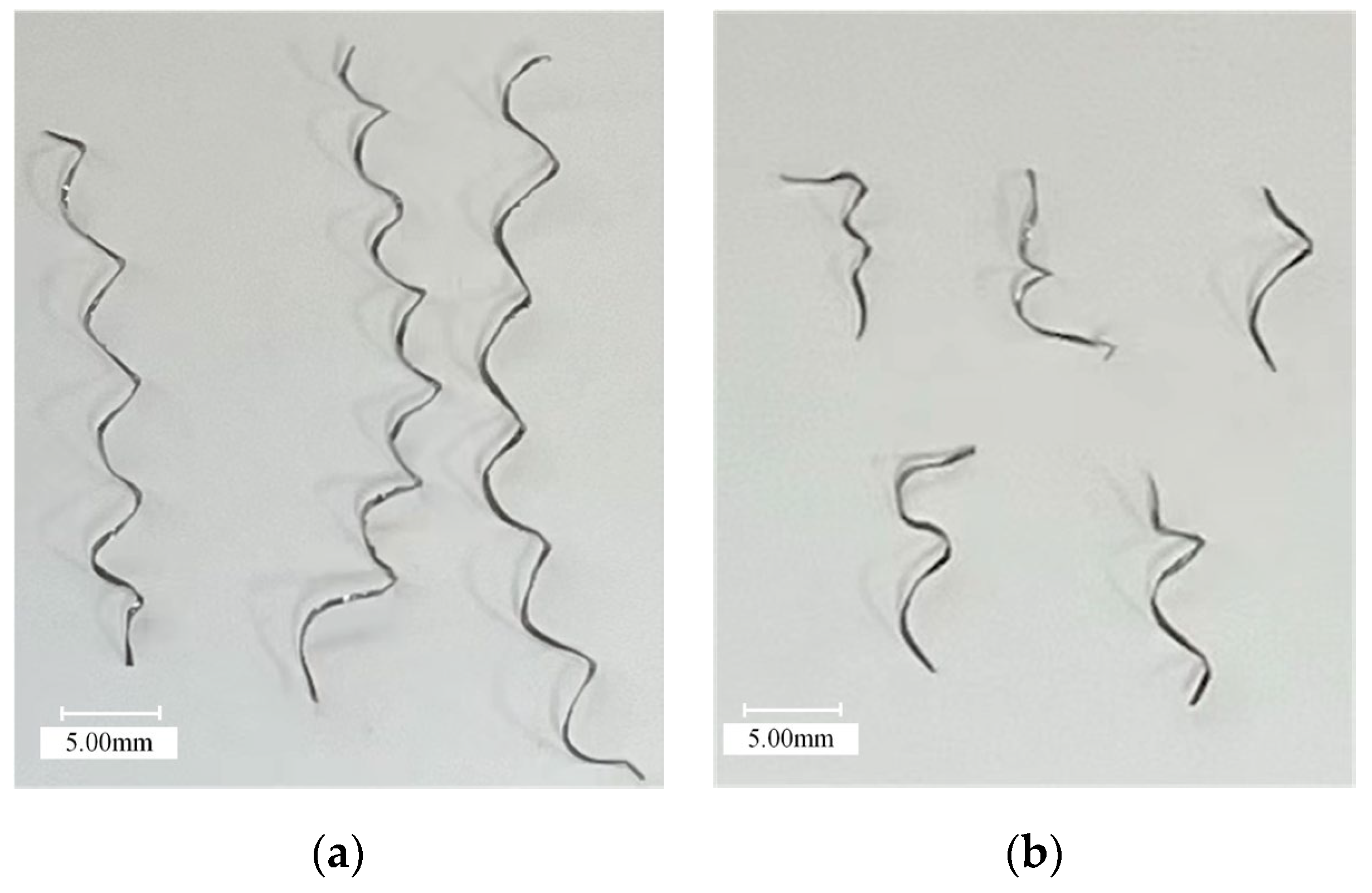

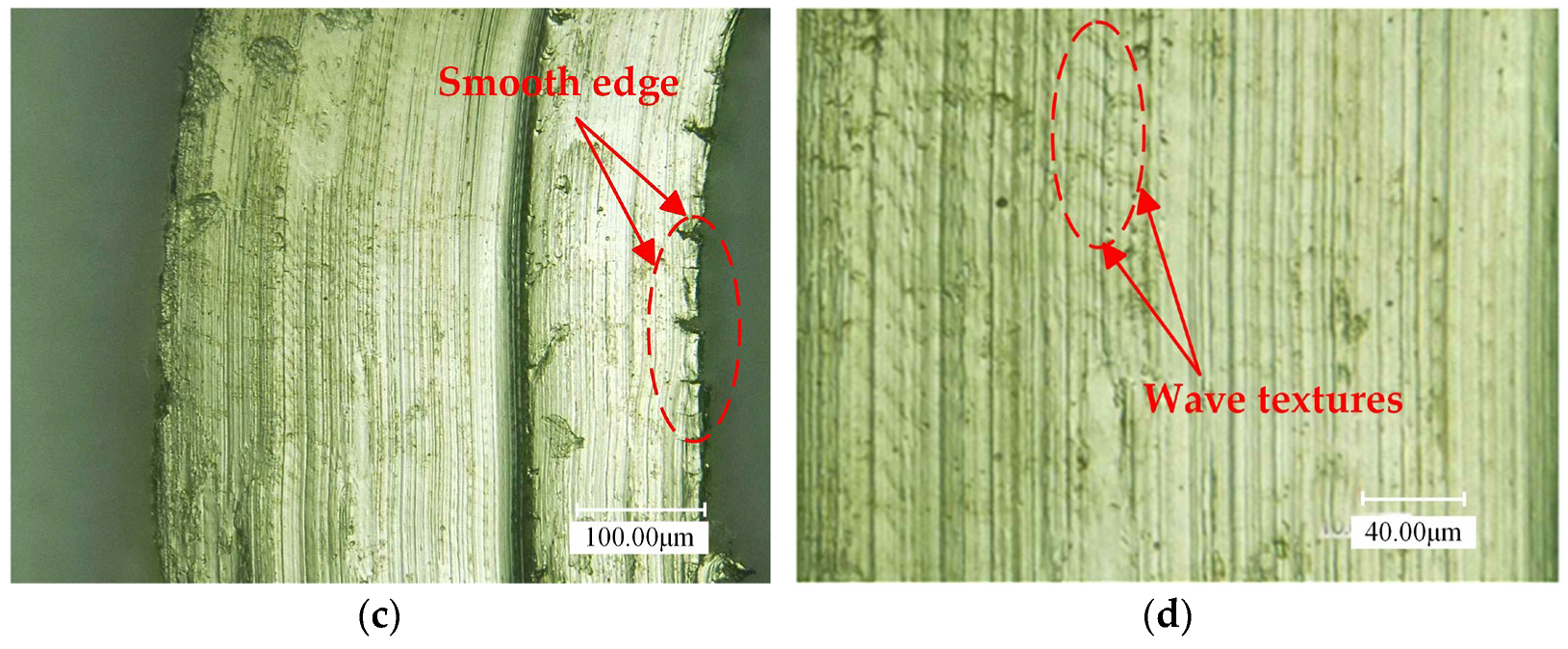
| Project | Content |
|---|---|
| Insert Part Number | WNMG080404N-TF |
| Nose angle (°) | 55 |
| Nose radius (mm) | 0.4 |
| Rake angle (°) | 7 |
| Rear angle (°) | 0 |
| Elements | Al + Ti | Co | W | Cr | Mo | Ni |
|---|---|---|---|---|---|---|
| Weight % | 7.83 | 24.83 | 1.19 | 13.85 | 2.79 | Bal. |
| Exp. No | Cutting Speed (m/min) | Feed Rate (mm/rev) | Depth of Cut (mm) | Vibration Amplitude (μm) |
|---|---|---|---|---|
| 1 | 14, 27, 40, 53, 66 | 0.08 | 0.15 | 12, - |
| 2 | 27 | 0.08, 0.12, 0.16, 0.20, 0.24 | 0.15 | 12, - |
| 3 | 27 | 0.08 | 0.05, 0.1, 0.15, 0.20, 0.25 | 12, - |
| 4 | 27 | 0.08 | 0.15 | -, 3, 6, 9, 12 |
Disclaimer/Publisher’s Note: The statements, opinions and data contained in all publications are solely those of the individual author(s) and contributor(s) and not of MDPI and/or the editor(s). MDPI and/or the editor(s) disclaim responsibility for any injury to people or property resulting from any ideas, methods, instructions or products referred to in the content. |
© 2023 by the authors. Licensee MDPI, Basel, Switzerland. This article is an open access article distributed under the terms and conditions of the Creative Commons Attribution (CC BY) license (https://creativecommons.org/licenses/by/4.0/).
Share and Cite
Kang, R.; Zhang, P.; Wei, Z.; Dong, Z.; Wang, Y. Experimental Study on Ultrasonic Assisted Turning of GH4068 Superalloy. Materials 2023, 16, 3554. https://doi.org/10.3390/ma16093554
Kang R, Zhang P, Wei Z, Dong Z, Wang Y. Experimental Study on Ultrasonic Assisted Turning of GH4068 Superalloy. Materials. 2023; 16(9):3554. https://doi.org/10.3390/ma16093554
Chicago/Turabian StyleKang, Renke, Pengnan Zhang, Zhaocheng Wei, Zhigang Dong, and Yidan Wang. 2023. "Experimental Study on Ultrasonic Assisted Turning of GH4068 Superalloy" Materials 16, no. 9: 3554. https://doi.org/10.3390/ma16093554
APA StyleKang, R., Zhang, P., Wei, Z., Dong, Z., & Wang, Y. (2023). Experimental Study on Ultrasonic Assisted Turning of GH4068 Superalloy. Materials, 16(9), 3554. https://doi.org/10.3390/ma16093554







